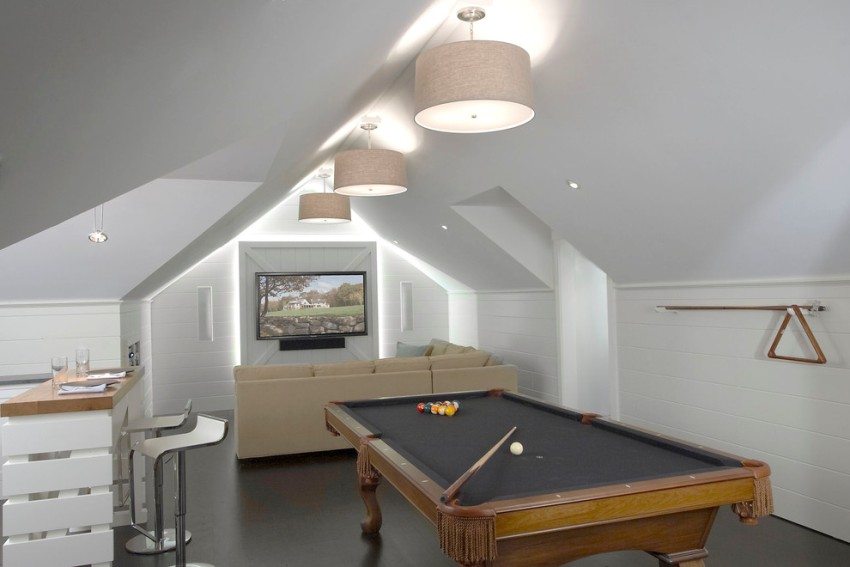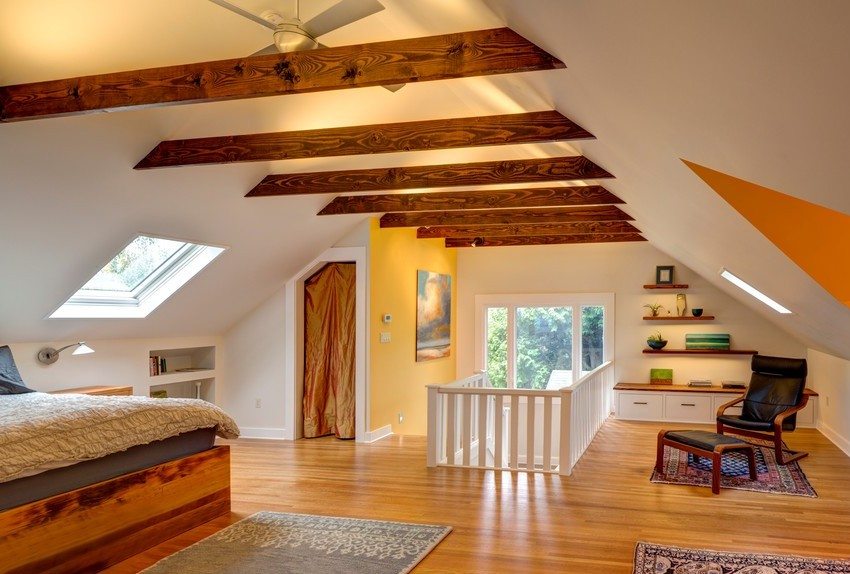Do-it-yourself attic finishing options, photos of which amaze with the non-standard nature of their architecture, must be studied before starting finishing work in the attic. An important difference between the attic and other rooms in the house lies in the arrangement of its walls. Rather, everyone decides for himself whether the walls or ceiling will be the roof slopes located on the sides of the room. It depends on the way of decoration and interior design.
Content [Hide]
Preliminary work before facing the attic
Even an ordinary attic with steep slopes reaching the very floors can be turned into an attic, if desired. To do this, it will be enough to build low walls on both sides. In this case, the inset of the ceiling windows and the decoration of the supporting beams of the rafter system will be an original and practical solution.
Related article:
House with an attic: photos, projects, planning features. Advantages, disadvantages and features of various layouts of the residential attic floor. Create a project yourself.
If a produce high-quality insulation and finishing of the formed attic floor, this will allow you to acquire several completely full-fledged rooms. It is necessary to formulate several principles that should be adhered to when carrying out work on insulation:
- slopes should be ideally protected from various precipitation and wind. They must withstand wide temperature changes;
- the roof is insulated not only inside, but also outside. This gives a good guarantee that freezing and drafts can be avoided even in the most severe winter;
- as an insulating finish for attic rooms, in addition to the actual insulation, drywall should be used or magnesite and cement-particle boards, which retain heat well;
- the entire "pie" of insulation should contain an inner layer of vapor barrier and an outer layer of wind protection. This will prevent condensation from forming inside the walls and prevent wind from penetrating under the sheathing.
Next, we will analyze each stage of finishing work in more detail.
Finishing the ceiling that is the attic floor
To correctly make the floor in the attic, you will need to create a soundproof layer inside the floor. For this purpose, any soundproofing material can be used.Mineral wool copes well with this task. Mattresses from it are laid out between the floor beams, not forgetting to first spread the film on them. The thickness of mineral wool can be from 5 to 10 cm. Expanded clay, granulated foam insulation or polystyrene chips are good. These measures also insulate the floor in the attic.

For finishing floor in the nursery the room can be used vinyl tiles
Useful advice! Do not use foam as sound insulation. It absorbs sounds poorly, but is popular with mice, which chew it with pleasure and make nests in it.
A subfloor should be laid on top of the beams. If the beams are less than 40 cm apart, then you can lay plywood directly on them, DSP or other similar sheet material. If the beams are far away, then you first need to lay boards (unedged) on them with a thickness of at least 3.5 cm. The main condition is that the subfloor should not bend when walking. Already on them the same is screwed onto self-tapping screws plywood.
Topcoat on the attic floor
Do-it-yourself attic finishing options (photo proof of this) imply the use of a wide variety of finishing floor coverings. You can use all the same materials as in ordinary rooms: laminate, linoleum, carpet and even ceramic tiles (if a bathroom or kitchen will be located in the attic).
For laying parquet or laminate first, a special underlay must be laid on the floor, which will not only ensure the softness of the floating floor, but also provide additional sound insulation. For laying tiles, a cement screed device is required with mandatory use reinforcing mesh.
Do-it-yourself attic finishing options, photos of walls and ceilings
Partly or completely, the walls of the attic room are the roof. If the house is originally built with an attic, then warming should be carried out immediately after the construction of the rafter system. To do this, boards or plywood are hemmed from below to the rafter legs, and a vapor barrier membrane is placed on top of them.
This must be done correctly by reading on the packaging which side it should be laid on. Insulation is laid on top of the membrane, fastened, and lathing slats under the roofing material are nailed onto the rafter legs. All this is covered with a windproof film and the roof is mounted.

Full studio apartment, furnished in the attic of a private house
As a result, the roof slopes will have good thermal insulation. In another version, do-it-yourself attic decoration (the photo will not let you cheat) is done after the construction of the house. In this case, the insulation is hemmed from the inside, and the walls are made of plasterboard, plywood or other sheet material on it. Insulation of the gable walls of the attic is done in the same way.

Wide plastic windows provide natural sunlight in the attic
Attic decoration with plasterboard sheets
When decorating the walls in the attic with plasterboard, we win many times over, since it allows you to immediately level and insulate the walls, it is easy to handle and install, it can be decorated with any finishing material, even wallpaper. In addition, drywall allows you to create various architectural "excesses" such as niches, arches and columns. The technology of finishing the attic with GKL sheets is no different from the method of finishing any other room.
Finishing the wall and ceiling space
One of the mainstream trends in the design of the attic floor is its finishing with Euro lining.Although this is one of the oldest ways, it has not lost its relevance among modern designers. If you initially plan to sheathe the attic floor with wood, then you do not need to create walls from drywall.
It will be enough to hem the boards to the rafters close to each other. It is even better if they have a groove and ridge, like a floor strip. In this case, the lining can be fixed directly to the walls without erecting an additional frame.
The wealth of options for wood decor allows you to use the lining in a completely different way:
- painting lining boards with light tones mixed with dark ones will very effectively highlight this decorative facing in the interior;
- if you use a block house, you can very gracefully divide the room into different zones. In this case, the visible parts of the rafter system can contrast with the walls. They can be dyed stain the most suitable color shade;

Decorating the walls of the attic with decorative MDF panels
- Wallpaper with silk-screen printing on a plywood base along the entire wall will be very appropriate. This decoration must be framed with a decorative molding;
- antique furniture "semi-antique" is especially effectively combined with similar walls.
Useful advice! Is your interior a little boring? He is able to revive decorative rock, with which you can trim a small fragment of the wall.
Cladding technology with eurolining
For some, fastening the euro lining to the frame is preferable to other do-it-yourself attic finishing options. Photos of this process can consistently illustrate the procedure for carrying out all the work:
- we buy the lightest types of lining, which include: maple, ash, fir, spruce. This will visually slightly increase the space;
- we will need slats 5-15 cm wide;
- we connect them together with a ready-made groove and a ridge;

Wooden lining is an environmentally friendly material, it is suitable for decoration children's rooms
- before starting installation on the walls, we stuff the frame from a 15x45 mm rail through an interval of 50 cm;
- we fasten the lining with special brackets or small nails to the correctly built frame;
- then we cover the surface of the rails with a protective film. For these purposes, we use varnish, stain or mastic.
Useful advice! To slightly dilute the completely monotonous interior of the walls made of eurolining, you can use cladding MDF panels... They create harmony in the interior, warmth and durability. Particularly effective is the bottom of the wall, which is decorated with MDF with a cork coating, and wooden skirting boards and it is better to make all kinds of slats a little darker.
As we can see, there are numerous options for finishing the attic with your own hands. Photos of many of them tell us that we can do this too. The main thing here is to show imagination and accuracy. At the same time, do not forget about the recommendations that we gave you. It is the decoration of the attic inside that will expand the territory to a light and spacious personal office, an excellent billiard room, gym or living room.















